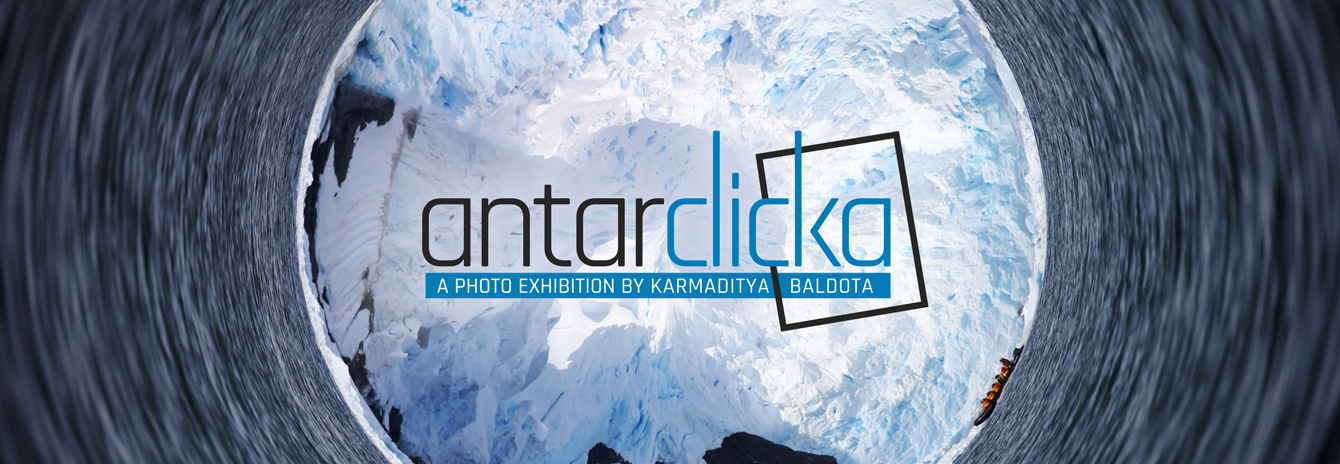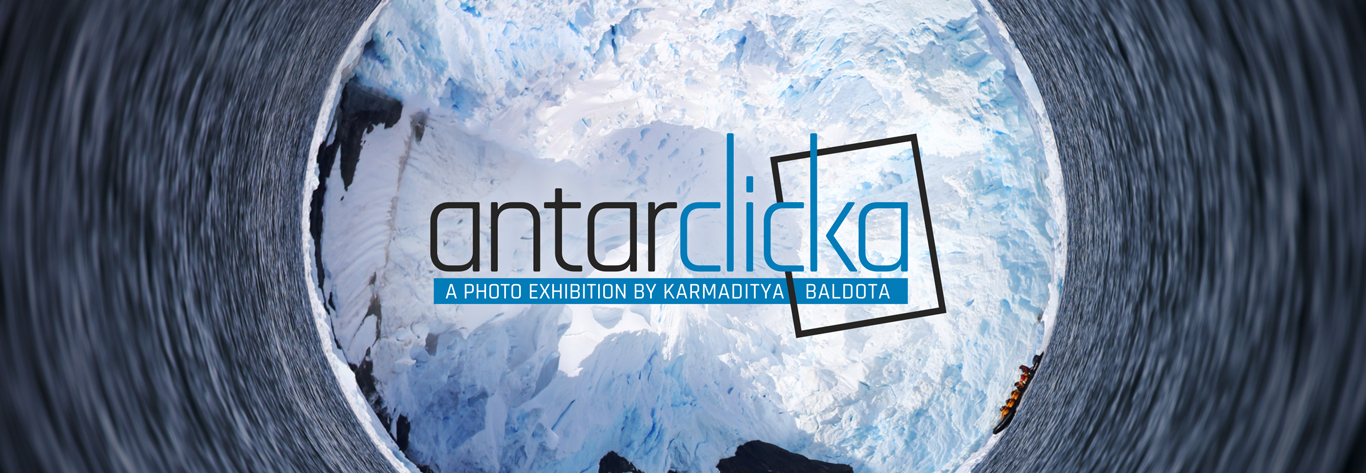
Inauguration by
British record-breaking adventurer, speaker, coach, sustainability campaigner and author.
NCPA-Piramal Art Gallery, Mumbai.
12th to 17th January, 2018
12:00 noon to 7:00 pm
Antarctica is the last and largest unspoiled wilderness area on Earth. It is a reminder of what the planet was like before the influence of man. The whole of mankind benefits from this isolated continent. Karmaditya Baldota, has captured through his lens the pristine beauty and unique marine life which includes whales breaching, seals sleeping and penguins playing. His photographs transport you to this frozen windswept continent and show you in vivid detail what we stand to lose due to climate change.

-

This Elephant, Roars
Antarclicka
This Elephant, Roars
A Southern Elephant Seal roars near the sub-Antarctic waters. They are the oddest marine mammals alive. Extreme divers, elephant seals can dive over 4,921 feet. They are also great at holding their breath and can remain submerged under water for up to two hours straight. Elephant seals survive on fish, squid and other marine foods.
-

Bathing Beauty
Antarclicka
Bathing Beauty
A Southern Elephant seal strikes a pose for the camera after an elaborate bathing session at the sea. South Georgia is home to the largest population of southern elephant seals, hosting more than half of the world’s population. They feed exclusively at sea and the main source of food is fish and squid.
-

Bear Hug
Antarclicka
Bear Hug
King Penguins hug each other at the start of the breeding season. This King penguin pair has finally made it to the point of mating. Courtship has already been in progress for several days. Because of a penguin's anatomy, the male must stand on the back of the female to fertilize her egg, as is the case with many other birds such as ducks.
-

The Bow of the Ship
Antarclicka
The Bow of the Ship
The ocean tide sculpts giant iceberg into the structure of the bow of the ship. The largest icebergs (also referred to as ice islands) originate from the vast ice shelves surrounding Antarctica. 90% of an iceberg is under water and hence the phrase “tip of the iceberg†came in to being.
-

The Curious One
Antarclicka
The Curious One
Adelie Penguin standing on the edge of the iceberg looks at the ocean curiously. Adelie Penguins are the tiniest, and the most widespread, penguin in the Antarctic. They have a feisty attitude and are known to take on potential predators – seals or large seabirds – or even attack visiting researchers with their flippers.
-

Home Alone
Antarclicka
Home Alone
Adelie Penguin standing on the edge of the iceberg looks at the ocean curiously. Adelie Penguins are the tiniest, and the most widespread, penguin in the Antarctic. They have a feisty attitude and are known to take on potential predators – seals or large seabirds – or even attack visiting researchers with their flippers.
-

Glow in the Dark
Antarclicka
-

24 KT Gold
Antarclicka
-

Honorary Lap
Antarclicka
Honorary Lap
The Skua flies low over the Antarctic ocean in search of prey. They are excellent fliers and have occasionally been sighted deep in the interior of the south pole. Skuas tend to have a reputation as being fierce and aggressive birds. For most Skua species the eggs and young ones of other birds are an important food source during the nesting season.
-

Gliding Over The Ocean
Antarclicka
Gliding Over The Ocean
The Southern Giant Petrel hovers around the Antarctic ocean keeping its eye on the prey. The Petrels are aggressive predators and scavengers, inspiring another common name, the stinker. At sea, they feed on krill, squid, and fish, often following fishing fleets in the hope of picking up offal.
-

Just Wondering
Antarclicka
Just Wondering
A Giant Wandering Albatross is captured wondering here. These birds are efficient gliders, and fly 1,000 km just for breakfast rarely flapping their wings. Their wings measure up to 3.5 meters in span and comes with a mechanism within the base of the wing to “lock†it in an extended position, so that the bird doesn't need to strain to keep its “arms†out.
-

Macaroni Says Cheese
Antarclicka
Macaroni Says Cheese
Macaroni Penguins make the best of photo opportunity in a colony in the Antarctic ocean. They get their name from the yellow crest feathers on their head. These penguins are migratory, aggressive and territorial penguins; males often become involved in fights with other individuals in the colony.
-

We Are a Family
Antarclicka
-

Breach Of ‘HONOUR’
Antarclicka
-

Tail-a-Tale
Antarclicka
-

Occupy Antarctic
Antarclicka
Occupy Antarctic
Thousands of King Penguins are seen standing in a colony as if gathered for a mass rally in Sub-Antarctic island. The king penguins have the longest breeding cycle of all the penguin species, lasting 14 to 16 months. A female king penguin may produce a chick during alternate breeding seasons.
-

Peak Of The Mountain
Antarclicka
Peak Of The Mountain
Ocean tides have sculpted the two icebergs as big as the mountain. Such towering, sculpted white and blue icebergs are an iconic symbol of Antarctica. The icebergs look blue in color because of the freshwater ice. The nontabular icebergs come in different shapes like rounded tops, spires and sloping sides. Wind and water erode the icebergs into various amazing structural shapes.
-

Float Through
Antarclicka
-

Tip of the Iceberg
Antarclicka
Tip of the Iceberg
Icebergs come in all shapes and sizes. The one here is a 3 sq. km wide. Only 1/10th part of the iceberg is visible over the water, with the remaining part submerged below the water, thus, making it look smaller. Tabular icebergs like this have steep sides and a flat top like a plateau.
-

Floating Around
Antarclicka
Floating Around
Icebergs are formed when chunks of ice break off from glaciers, ice shelves or even a larger iceberg. They travel with the ocean currents, and when an iceberg reaches warm waters, the warm air melts the snow and ice into pools called the “melt pondsâ€. The warm water also laps at the edges of the icebergs, melting the ice and causing chunks of ice to break off.






















